
(a)
Interpretation:
The structure of D-Allose: Epimeric at C-3 should be determined.
Concept introduction:
Carbohydrates are a large group of organic compounds that are present in foods, living tissues. These include sugars, cellulose, and starch. Anomers are the glycosides or cyclic monosaccharides that are epimers. These are different from each other in the configuration of C-1 (aldoses) or at C-2 if (ketoses).
Answer to Problem 9P
The structure of D-Allose:
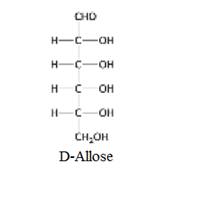
Explanation of Solution
When two sugars vary in their configuration around one carbon atom then those sugars are known as epimers of each other.
The structure of D-Allose: Epimeric at C-3 is given below:
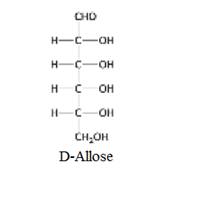
(b)
Interpretation:
The structure of D-Altrose: Isomeric at C-2 and C-3 should be determined.
Concept introduction:
Carbohydrates are a large group of organic compounds that are present in foods, living tissues. These include sugars, cellulose, and starch. These are comprised of hydrogen and oxygen in a similar ratio as in water (2:1). They are usually broken down to release the energy in the animal body. These are of three types: monosaccharides, disaccharides, and polysaccharides.
Answer to Problem 9P
The structure of D-Altrose:
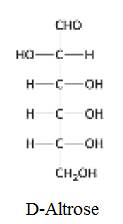
Explanation of Solution
Glucose is an aldose as it contains one
The structure of D-Altrose: Isomeric at C-2 and C-3 is given below:
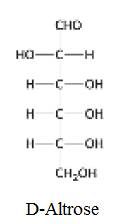
(c)
Interpretation:
The structure of D-Mannose: Eplmeric at C-2 should be determined.
Concept introduction:
Carbohydrates are a large group of organic compounds that are present in foods, living tissues. These include sugars, cellulose, and starch. These are comprised of hydrogen and oxygen in a similar ratio as in water (2:1). They are usually broken down to release the energy in the animal body. These are of three types: monosaccharides, disaccharides, and polysaccharides.
Answer to Problem 9P
The structure of D-Mannose:
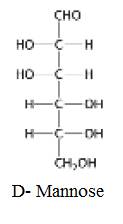
Explanation of Solution
Anomers are the glycosides or cyclic monosaccharides that are epimers. These are different from each other in the configuration of C-1 (aldoses) or at C-2 if (ketoses). In a pair of anomers, the anomer containing the alkoxy group or hydroxy group is pointing up on the anomeric carbon is known as the ß-anomer.
The structure of D-Mannose: Eplmeric at C-2 is given below:
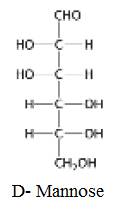
(d)
Interpretation:
The structure of D- Gulose: Isomeric at C-3 and C-4
should be determined.
Concept introduction:
Carbohydrates are a large group of organic compounds that are present in foods, living tissues. These include sugars, cellulose, and starch. These are comprised of hydrogen and oxygen in a similar ratio as in water (2:1). They are usually broken down to release the energy in the animal body. These are of three types: monosaccharides, disaccharides, and polysaccharides.
Answer to Problem 9P
The structure of D- Gulose:
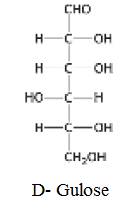
Explanation of Solution
Glucose is an aldose as it contains one aldehyde group per molecule in its acyclic form. Mannose is a sugar of the hexose group. It occurs as a constituent of several natural polysaccharides.
The structure of D- Gulose: Isomeric at C-3 and C-4 is given below:
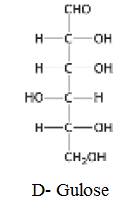
(e)
Interpretation:
The structure of D-Idose: Isomeric at C-2, C-3, and C-4 should be determined.
Concept introduction:
Carbohydrates are a large group of organic compounds that are present in foods, living tissues. These include sugars, cellulose, and starch. These are comprised of hydrogen and oxygen in a similar ratio as in water (2:1). They are usually broken down to release the energy in the animal body. These are of three types: monosaccharides, disaccharides, and polysaccharides.
Answer to Problem 9P
The structure of D-Idose:
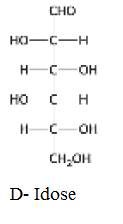
Explanation of Solution
Glucose is an aldose as it contains one aldehyde group per molecule in its acyclic form. Mannose is a sugar of the hexose group. It occurs as a constituent of several natural polysaccharides.
The structure of D-Idose: Isomeric at C-2, C-3, and C-4 is given below:
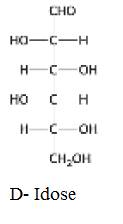
(f)
Interpretation:
The structure of D-Galactose: Epimeric at C-4 should be determined.
Concept introduction:
Carbohydrates are a large group of organic compounds that are present in foods, living tissues. These include sugars, cellulose, and starch. These are comprised of hydrogen and oxygen in a similar ratio as in water (2:1). They are usually broken down to release the energy in the animal body. These are of three types: monosaccharides, disaccharides, and polysaccharides.
Answer to Problem 9P
The structure of D-Galactose:
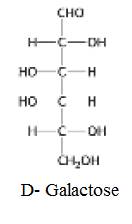
Explanation of Solution
Glucose is an aldose as it contains one aldehyde group per molecule in its acyclic form. When two sugars vary in their configuration around one carbon atom then those sugars are known as epimers of each other.
The structure of D-Galactose: Epimeric at C-4 is given below:
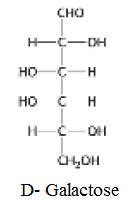
(g)
Interpretation:
The structure of D-Talose: Isomeric at C-2 and C-4 should be determined.
Concept introduction:
Carbohydrates are a large group of organic compounds that are present in foods, living tissues. These include sugars, cellulose, and starch. These are comprised of hydrogen and oxygen in a similar ratio as in water (2:1). They are usually broken down to release the energy in the animal body. These are of three types: monosaccharides, disaccharides, and polysaccharides.
Answer to Problem 9P
The structure of D-Talose:
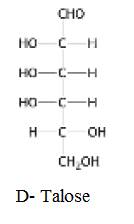
Explanation of Solution
Glucose is an aldose as it contains one aldehyde group per molecule in its acyclic form. When two sugars vary in their configuration around one carbon atom then those sugars are known as epimers of each other.
The structure of D-Talose: Isomeric at C-2 and C-4 is given below:
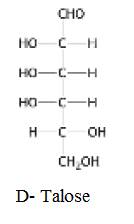
Want to see more full solutions like this?
Chapter 11 Solutions
BIOCHEMISTRY
- 9) Below, there is a representation of an SDS-PAGE gel. Assuming the samples in the MW standard have masses of: 66 kDa, 45 kDa, 36 kDa, 29 kDa, 24 kDa, 20.1 kDa, and 14.2 kDa, a) Figure 4: indicate where each of the measurements were taken and label as in II.6. figure 2 above. b) As in II.7. Table 1 above create Table 2 using the data below. Determine the r.f. values for the MW standards, plot the relative mobility versus the log of the mass for the standards, and use the best fit straight line to determine the molecular weights of the proteins in the whey, peak 1, and peak 2 lanes. (5 pts—this will be scaled up appropriately if your gel did not develop properly) dye MW Whey Peak 1 Peak 2arrow_forwardwhat are the different classes and some examples of neuroprotectants that can be used to treat, prevent, or combat neurotoxicity/a neurotoxicant...for example, antioxidants, nutraceuticals, etc.,..?arrow_forwardImagine that aldolase can react with the seven carbon molecule Sedoheptulose-1,7-bisphosphate (below). Use the mechanism to predict the two products generated. Please draw out the stereochemistry in a fischer projection.arrow_forward
- Sodium borohydride (NaBH4) is a potent inhibitor of aldolase. It is known to ONLY inhibit theenzyme when it is complexed with substrate. Treatment of the enzyme alone has no effect.What is the mechanism for this inhibition? Please draw out the mechanism and show how it inhibits this.arrow_forwardShow the fate of the proton on the 4-Oxygen molecule of F-1,6-BP. Please include a drawing showing the electron flow that occurs.arrow_forward1. Which one is the major organic product obtained from the following aldol condensation? O NaOH, H₂O heat A B C D Earrow_forward
- An organic chemist ordered the wrong item. She wanted to obtain 1-hydroxy-2-butanone, butinstead ordered 2-hydroxybutyraldehyde. As a good biochemist, show how the organic chemistcould use biological catalysis to make her desired compound. Please show the mechanism by drawing.arrow_forwardShow the fate of the hydrogen on carbon-2 of glucose. Please draw out the structure using curve arrows to show electron flow.arrow_forward3. Which one of the compounds below is the major product formed by the reaction sequence shown here? CH3 + CH3NO2 NaOH H2, Ni ? nitromethane acetophenone OH OH HO HN- u x x x x Ph A HO -NH2 HO H Ph Ph Ph N- H B Ph NH2 D Earrow_forward
- 4. Only ONE of the five compounds below can be prepared by an aldol condensation in which a single carbonyl compound is treated with base. Which one is it? To solve this problem, reverse the aldol condensation that formed each of these molecules to find out what two molecules came together to make the products. The one in which the two molecules are identical is the answer. Ph Ph ཚིག གནས ག ནཱ ཀ ན ཀནཱ A Ph H B Ph Ph H D Ph. Ph Ph E Harrow_forward5. Which one is the major organic product obtained from the following reaction sequence? First, equimolar amounts of cyclopentanone and LDA are mixed at -78°C. Then propionaldehyde (propanal) is added. Addition of aqueous acid completes the process. LDA, -78°C. 1. 2. H₂O* H A B H 0 D H H Earrow_forward2. Which one is the major organic product obtained from the following reaction? NaOH, H₂O heat A B C D Earrow_forward
 BiochemistryBiochemistryISBN:9781305577206Author:Reginald H. Garrett, Charles M. GrishamPublisher:Cengage Learning
BiochemistryBiochemistryISBN:9781305577206Author:Reginald H. Garrett, Charles M. GrishamPublisher:Cengage Learning Biology (MindTap Course List)BiologyISBN:9781337392938Author:Eldra Solomon, Charles Martin, Diana W. Martin, Linda R. BergPublisher:Cengage Learning
Biology (MindTap Course List)BiologyISBN:9781337392938Author:Eldra Solomon, Charles Martin, Diana W. Martin, Linda R. BergPublisher:Cengage Learning Biology: The Dynamic Science (MindTap Course List)BiologyISBN:9781305389892Author:Peter J. Russell, Paul E. Hertz, Beverly McMillanPublisher:Cengage Learning
Biology: The Dynamic Science (MindTap Course List)BiologyISBN:9781305389892Author:Peter J. Russell, Paul E. Hertz, Beverly McMillanPublisher:Cengage Learning Human Heredity: Principles and Issues (MindTap Co...BiologyISBN:9781305251052Author:Michael CummingsPublisher:Cengage Learning
Human Heredity: Principles and Issues (MindTap Co...BiologyISBN:9781305251052Author:Michael CummingsPublisher:Cengage Learning BiochemistryBiochemistryISBN:9781305961135Author:Mary K. Campbell, Shawn O. Farrell, Owen M. McDougalPublisher:Cengage Learning
BiochemistryBiochemistryISBN:9781305961135Author:Mary K. Campbell, Shawn O. Farrell, Owen M. McDougalPublisher:Cengage Learning





